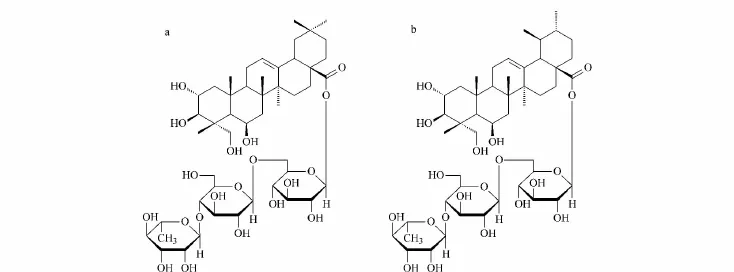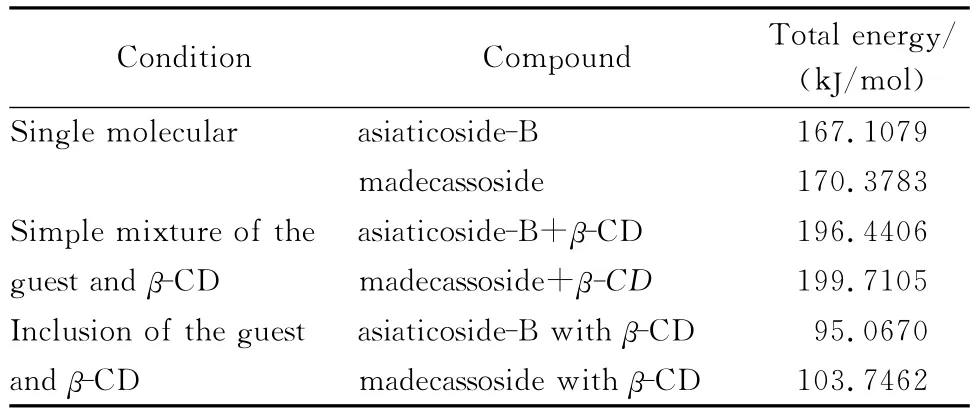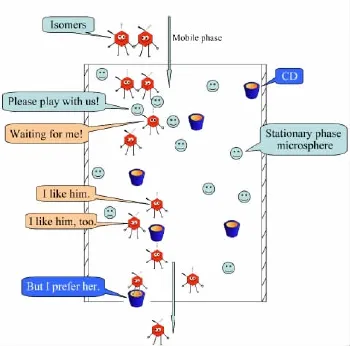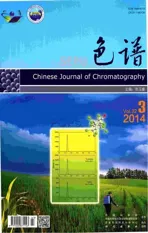齐墩果烷型和乌苏烷型五环三萜同分异构体配位色谱法分离机理
2014-05-08开桂青王焕明
开桂青, 刘 柳, 王焕明
(1.安徽大学生命科学学院,安徽 合肥230601;2.安徽友勇生物科技有限公司,安徽 六安231300)
There are many oleanolic and ursolic pentacyclic triterpenoid isomers in natural plants,such as Centella Asiatica (Fig.1),Fructus Ligustri Lucidi and Folium Eriobotryae.The previous studies reported that these isomers showed therapeutic effects[1].Centella Asiatica increases collagen synthesis in vitro and extracellular matrix accumulation in vivo.It was found to attenuate anxiety-related disorders and reduce stress phenomenon in clinical studies[2,3].

Fig.1 Molecular structures of(a)asiaticoside-B and(b)madecassoside
The conventional analysis methods of the triterpenoids in plants include liquid chromatography[4-7],gas chromatography after silylation and methylation[8,9].The capillary supercritical fluid chromatography and high performance thin-layer chromatography combined with densitometry have also been used for the plant analysis[10-13].
Many of the oleanolic and ursolic pentacyclic triterpenoid isomers often exist together,which might be resulted from the same biosynthesis pathway of them.The place of methyl group in E cyclic is the only difference in their structure,which results in the similar physicochemical property.They are difficult to be separated by the common analytical methods.
The separation of asiaticoside,madecassoside,madecassic acid and asiatic acid was studied in the literature[14,15].However,few work has been done on the separation of asiaticoside-B and madecassoside[16,17].The separation of oleanolic and ursolic acids was studied in several papers with special HPLC[18-20].
The theory of coordination chromatography separation is based on the differences in the structures of the target substances and impurities.This separation method has high selectivity in target substances and impurities,which can reach high resolution.Some studies reported that betulinic,oleanolic and ursolic acids can achieve a good separation by coordination chromatography [21]. However the separation mechanism was not disclosed.In this paper,based on the coordination chromatography theory and the characteristic of cyclodextrins(CD),suitable CDs were selected by the chemical calculation and the separation mechanisms were proposed.
1 Experimental section
1.1 Reagents and equipment
The reference standard of madecassoside was purchased from National Institute for the Control of Pharmaceutical and Biological Products of China(Beijing,China).Asiaticoside-B was kindly offered by Hefei Tuofeng Biotechnology Co.,Ltd.The extract powder of 70% (w/w)total Centella triterpenes was bought from Guangxi Changzhou Natural Products Development Co.,Ltd.(Guangxi,China).β-CD was obtained from the Fine Chemicals Factory,Nankai University (Tianjin,China).Glucosyl-β-cyclodextrin (Glu-β-CD)and dimethyl-β-CD (DM-β-CD) were bought from Shandong Xinda Group Co.,Ltd.(China).
The D-2000 Elite HPLC system consists of a highpressure constant flow pump(L-2130),a UV spectrophotometric detector(L-2420)and an autosampler(L-2200).The analytical column is an Agilent Zorbax SB-C18(250 mm×4.6 mm,5μm).The flow rate of the mobile phase was 0.8 mL/min.The wavelength of UV detector was set at 204 nm.The temperature of the column was 25℃.A10 mL volume of sample was injected into the column.Nicolet 5700 Fourier transform infrared spectrometer(Thermo Fisher Scientific,Inc.).
1.2 Sample preparation
The extract powder of Centella (70% (w/w)of total Centella triterpenes)was accurately weighed(40 mg),and dissolved in methanol to 10 mL solution.The solution was filtered through a 0.45-μm filter and the clear filtrate was used for HPLC analysis.The reference standards of madecassoside and asiaticoside-B were processed by the same way.
1.3 Mobile phase
The mobile phases for the separation of madecassoside and asiaticoside-B consisted of acetonitrile and water solution(25∶75,v/v)with the addition of 4 mmol/L of DM-β-CD,β-CD or Glu-β-CD.The solutions were filtered through0.45-μm filters and the clear filtrates were used as the HPLC mobile phases.
1.4 Screening coordination agents
The space sizes of the isomeric compounds(only around the place of methyl group in E cyclic)were simulated and calculated by Chemoffice 2008.The minimum energies betweenβ-CD and the guest were also calculated before and after inclusion respectively.
1.5 Inclusion complexes preparation
β-CD was accurately weighed and dissolved in a certain amount of distilled water.The equimolar amount of asiaticoside-B was accurately weighed and dissolved in ethanol,followed by adding into theβ-CD solution.The mixed solution was stirred at 40℃ with a magnetic bar for 1 h,and then freezedried.Finally,the solid inclusion complexes were obtained.
2 Results and discussion
2.1 Screening coordination agents
CDs(α,β,γ)are torus-shaped,with the cyclic oligosaccharides composed of six to eightα-1,4 linked D-glucopyranose units per molecule (α-,βandγ-CD,respectively).The exterior of the CD molecule is hydrophilic,and its hydrophobic cavity may selectively include molecules with appropriately sized organic compounds by forming non-covalent inclusion complexes.First of all,the guest molecules must match the size of the CD cavity,which plays an important role in the stabilization of the complexes.α-CD,β-CD andγ-CD have different cavity diameters and selectively include the guest molecules with different sizes.Guest molecule is too big to enter the cavity.However,the inclusion compound is unstable if the guest molecule is too small.The space sizes of the isomeric compounds(only around the place of methyl group in E cyclic)were simulated and calculated.
The results showed that the space sizes of the isomeric compounds(only around the place of methyl group in E cyclic)were in the range of 0.377-0.560 nm (madecassoside:0.444 nm,0.560 nm;asiaticoside-B:0.377 nm,0.424 nm).The diameters ofα-,β-andγ-CD cavities are 0.470-0.530 nm,0.600-0.650 nm,0.750-0.830 nm,respectively.Thereby,the space sizes of the isomeric compounds are bigger than the diameter of α-CD cavity,which might make it difficult to enter into the cavity.The space sizes of the isomers are much smaller than the diameter ofγ-CD,which might result in the weak interactions betweenγ-CD and the guest,so that it could not form stable inclusion compound.Accordingly,β-CD should be the suitable agents.The appropriate interactions betweenβ-CD and guest might be formed.
The minimum energies betweenβ-CD and the guest were calculated before and after the inclusion respectively.As can be seen from Table 1,the total minimum energy in the inclusion of the guest andβ-CD decreased more quickly compared with the energy in the simple mixture of the guest andβ-CD,which indicates that the interactions between the guest andβ-CD formed.The results validate that the calculation is correct for selectingβ-CD as the suitable agents.

Table 1 Total minimum energies of the guest and β-CD under different conditions
According to the above analysis,β-CD and its derivatives were selected as the coordination agents.For studying the separation mechanisms,theβ-CD derivatives(Glu-β-CD and DM-β-CD)were selected according to their different hydrophilicities which are in the following order:Glu-β-CD > β-CD >DM-β-CD.
2.2 Stoichiometry and apparent formation constants of the complexes
Several studies have theoretically examined the competing equilibria in the column of an HPLC system upon the introduction of the solute into a mobile-phase mixture consisting ofβ-CD and a primary organic modifier[22-26].Based on the results of these studies,when isomeric compounds are introduced into the column in the presence ofβ-CD or its derivatives in the mobile phase,the equilibria presented in Fig.2 will be established.

Fig.2 Equilibria proposed for a 1∶1 isomers-β-CD inclusion complexAS or MA:asiaticoside-B or madecassoside;CD:β-cyclodextrin;AS or MA-CD:asiaticoside-B or madecassoside-β-CD complex;(AS or MA-CD)s:(asiaticoside-B or madecassoside-β-CD)scomplex;m:mobile phase;s:stationary phases;M:organic modifier;Km:affinity constant of the modifier for theβ-CD cavity;KF:apparent formation constant for the (asiaticoside-B or madecassoside-β-CD)complex in a 1∶1 model;K0:equilibrium constant of asiaticoside-B or madecassoside between mobile and stationary phases;K1:equilibrium constant of(asiaticoside-B or madecassosideβ-CD)complex between mobile and stationary phases;CD-M:β-CD-organic modifier interaction.
Since the organic modifier competes with isomeric compounds for theβ-CD cavity,the effectiveβ-CD concentration in the mobile phase([CD]m)is not the total analytical β-CD concentration([CD]T).[CD]mmust be calculated using the following equation [23,25,27]:

where[M]is the concentration of acetonitrile in the mobile phase.
Assuming that the interaction of the each complex(asiaticoside-B or madecassoside-β-CD)with the stationary phase is negligible[22],the relationship between the retention factor(k)and the effectiveβ-CD mobile-phase concentration([CD]m)can be established.An equation is proposed in taking into account the equilibria involving the formation of 1∶1 isomer-β-CD complexes[23-25]:

Where k0is the solute retention factor in the absence of CD.
According to the reported studies[25,28],the equilibria allow for 1∶2 asiaticoside-B or madecassoside-β-CD complexation.The equilibria presented in Fig.3 show the formation of a 1∶2 asiaticoside-B or madecassoside-β-CD complex via a precursor 1∶1 complex.
As shown in both Fig.2 and Fig.3,whenβ-CD is added to the mobile phase,the isomer retention is governed by its partition between the mobile phase,the stationary phase and the isomer complexation withβ-CD [25,29].Following the derivation of Mosheni et al[28],assuming that the interaction of the asiaticoside-B or madecassoside-β-CD complex with the stationary phase is negligible(K1≈0and K2≈0)[22],and including the terms that account for the possibility of a 1∶2 asiaticoside-B or madecassoside-β-CD complex,a similar mathematical expression can be derived,which describes the dependence of k of asiaticoside-B or madecassoside on the effective concentration ofβ-CD in the mobile phase([CD]m):

Equation 3 is an extension of Equation 2 and includes a second-order term that accounts for the possibility of a 1∶2 asiaticoside-B or madecassosideβ-CD complex formation.Equation 3 simplifies E-quation 2 when a 1∶1 isomer-β-CD complex is the only complex formed;the apparent formation constant of the 1∶2isomer-β-CD complex(KF2)is zero.In this case,aplot of the reciprocal of k versus[CD]mshould give a straight line.In the case of a 1∶2 isomer-β-CD complex formation,aplot of reciprocal of k versus[CD]mshould give a parabolic curve that fits Equation 3.The values of KF1and KF2can be obtained by per - forming a second-order polynomial fit to the data.

Fig.3 Equilibria proposed for a 1∶2 asiaticoside-B or madecassoside-β-CD inclusion complexKF1:apparent formation constant for the asiaticoside-B or madecassoside-β-CD complex in a 1∶1 model;KF2:apparent formation constant for the asiaticoside-B or madecassoside-(β-CD)2complex in a 1∶2 model;K2:equilibrium constant of asiaticoside-B or madecassoside-(β-CD)2complex between mobile and stationary phases.
To determine the stoichiometric ratios for isomerβ-CD complexes formed,both Equations 2 and 3 were used.The reciprocal of k for asiaticoside-B was plotted as a function of[CD]m.The correlation coefficients arising from this plot were determined as shown in Table 2.The linear relationship that fits Equation 2 indicates that a 1∶1 guest-CD complex is preferred.
For studying the separation mechanisms,Table 2 also reports the KFvalues of the complexes formed between asiaticoside-B and cyclodextrins (Glu-β-CD,β-CD,DM-β-CD).As expected,for asiaticoside-B,the KFvalues of Glu-β-CD (2 534)were larger than that ofβ-CD (1 467).To DM-β-CD,the relatively lower KFvalues can be attributed to their different hydrophilicities,which influence the hostguest interactions.
It is shown in Fig.4 that the madecassoside isomers could not be separated without CD in the mobile phase.However,the resolution between madecassoside isomers was increased obviously by adding DM-β-CD,β-CD or Glu-β-CD into the mobile phase.Nevertheless,the resolution of the madecassoside isomers with the addition of Glu-β-CD into the mobile phase(11.95)was higher than that with the addition ofβ-CD (9.61)or DM-β-CD (9.89).
2.3 Inclusion reaction
According to the theory of supramolecular chemistry,the infrared peaks of the characteristic absorb-tion have changed when forming the guest-CD complexes.Hence,the asiaticoside-B-β-CD complexes were confirmed by IR.From the IR spectra,the carbonyl group was the characteristic absorption peak of asiaticoside-B,which was located at 1 733.3 cm.The carbonyl group peak of asiaticoside-B-β-CD complexes was shifted to 1 726.8 cm comparing with the peak of the mixture of asiaticoside-B andβ-CD (1 735.4 cm).This phenomenon indicated the forming of asiaticoside-B-β-CD complexes.However,the characteristic absorption peak did not vanish,suggesting that the carbonyl group of asiaticoside-B might not enter into the cavity ofβ-CD.The carbonyl group was influenced by theβ-CD cavity.The peak at about 3 400 cm was caused by the hydroxyl absorption.To asiaticoside-B-β-CD complex,this peak became wider,which can be attributed to the hydrogen-bond interaction between the glycoside group of asiaticoside-B and the hydrophilic group ofβ-CD cavity exterior.The results can explain why the KFvalues between asiaticoside-B and CDs are in the following sequence:Glu-β-CD>β-CD> DM-β-CD.

Table 2 Apparent formation constants of asiaticoside-B with Glu-β-CD,β-CD or DM-β-CD

Fig.4 Chromatograms of 70% (w/w)total Centella triterpenesMobile phase:acetonitrile/water solution(25∶75,v/v)with the addition of 4 mmol/L DM-β-CD,β-CD or Glu-β-CD.1.asiaticoside-B;2.madecassoside.
2.4 Simulation the host-guest complexes structure
Based on the above analysis,the optimum structure of host-guest coordination compound was simulated by the software(Chemoffice 2008).From the simulation results,the methyl part of madecassoside or asiaticoside-B can enter into theβ-CD cavity,and the large glycoside parts are kept outside,forming hydrogen-bond interaction with the exterior ofβ-CD cavity.The results are consistent with the results of that in the IR spectra.
According to the above analysis,the proposed separation mechanism of coordination chromatography is schematically represented in Fig.5.As shown in Fig.5,the suitable agent was added to mobile phase.Following the mobile phase,the agent entered the stationary phase.There were many kinds of interaction occurred in the stationary phase between the isomers and the the agent,the isomers and the stationary phase microsphere,the isomers and the mobile phase,etc.The separation of oleanane and ursane pentacyclic triterpenoid isomers may be attributed to the collaborative effect of many kinds of interaction.

Fig.5 Separation mechanism of chromatographic process
3 Conclusion
The experimental results showed that the resolution of madecassoside isomers with the addition of Glu-β-CD into the mobile phase(11.95)was higher than that with the addition ofβ-CD (9.61)or DM-β-CD (9.89).The formation of 1∶1inclusion complexes was assumed.The KFvalues for asiaticoside-B with the addition of Glu-β-CD (2 534 L/mol)were relatively larger than that with the addition of β-CD (1 467 L/mol).For DM-β-CD,the low KFvalues can be attributed to their different hydrophilicities,which influence host-guest interactions.According to the infrared spectrum,the carbonyl group of asiaticoside-B might not enter into the cavity ofβ-CD,while the carbonyl group was influenced by theβ-CD cavity.The hydrogen-bond interactions were formed between the glycoside group of asiaticoside-B and the hydrophilic group ofβ-CD cavity exterior.
In the molecular structures of oleanane and ursane pentacyclic triterpenoids,the large glycoside parts formed different hydrogen bonding interactions with the cavity exterior of Glu-β-CD,β-CD or DM-β-CD.The molecular structure of madecassoside belongs to ursane category while asiaticoside-B belongs to oleanane category.The separation of oleanane and ursane pentacyclic triterpenoids can be attributed to steric differences,which lead to different chromatography behaviors.
[1] Zhang M F,Shen Y Q.Anti-Infection Pharmacy,2012,9:13
[2] Jana U,Sur T K,Maity L N,et al.Nepal Med Coll J,2010,12:8
[3] Aree W,Mayuree H T,Boonyong T,et al.J Ethnopharmacol,2012,143:579
[4] Hu C P,Chen L S,Xin Y,et al.Chinese Journal of Chromatography,2006,24(5):492
[5] Tan Q,Shou Q Y,Zhang S,et al.Chinese Journal of Chromatography,2010,28(12):1150
[6] Xiao C Z,Sheng H W.J Chromatogr B,2009,877:477
[7] Ha J K,Jae H P,Gyu T K.Microchem J,2011,98:115
[8] Rhourrhi-Friha B,Westa C,Pasquierb L,et al.J Chromatogr A,2012,1256:177
[9] Xie Y F,Yang Y Y,Liu J J,et al.Chinese Journal of Chromatography,2013,31(7):679
[10] Chi Y M,Zhang Y,Wang Q X,et al.Chinese Journal of Chromatography,2013,31(9):838
[11] Lesellier E,Destandau E,Grigoras C,et al.J Chromatogr A,2012,1268:157
[12] Li Z H,Tang G L,Pang Y Q,et al.Chinese Journal of Chromatography,2010,28(8):790
[13] Silvia A C,Stefano M.J Pharm Biomed Anal,2012,70:647
[14] Gao M Z,Yuan X Y,Xiao H B,et al.Chinese Journal of Chromatography,2008,26(3):362
[15] Pan J,Kai G Q,Yuan C X,et al.Chinese Journal of Chromatography,2007,25(3):316
[16] Kai G Q,Pan J.Bull Korean Chem Soc,2008,29:551
[17] Pan J,Kai G Q,Yuan C X,et al.Chromatographia,2007,66:121
[18] Yan L,Gong P,Yuan L,et al.Chinese Journal of Chromatography,2007,25(3):337
[19] Xu X H,Su Q,Zang Z H.Journal of Pharmaceutical Analysis,2012,2:238
[20] Zhang Y.Chinese Journal of Chromatography,2014,32(1):47
[21] Claude B,Morina P,Lafossea M,et al.J Chromatogr A,2004,1049:37
[22] Fujimura K,Ueda T,Kitagawa M.Anal Chem,1986,58:2668
[23] Clarot I,Clédat D,Battu S,et al.J Chromatogr A,2000,903:67
[24] Ravelet C,Geze A,Villet A,et al.J Pharm Biomed Anal,2002,29:425
[25] Moeder C,O’Brien T,Thompson R,et al.J Chromatogr A,1996,736:1
[26] Gazpio C,Sánchez M,García-Zubiri I X,et al.J Pharm Biomed Anal,2005,37:487
[27] Bielejewska A,Duszczyk K,Sybilska D.J Chromatogr A,2001,931:81
[28] Mohseni R M,Hurtubise R J.J Chromatogr A,1990,499:395
[29] Schneiderman E,Stalcup A M.J Chromatogr B,2000,745:83
